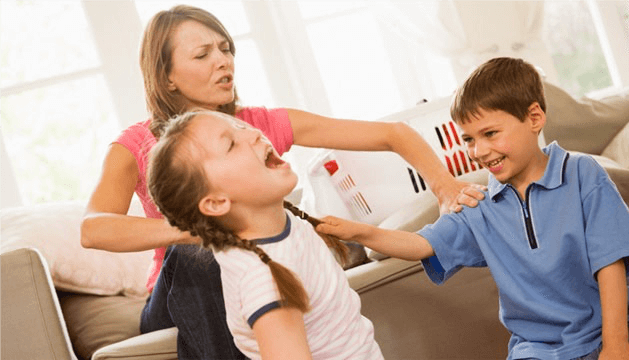
Do your children fight? Attack each other, physically or verbally, from out of nowhere, and often? Do you feel like you have tried everything to stop their fights – asked nicely or lectured, yelled, maybe threatened and even punished – but nothing has worked?
Watching your children fight is challenging and intense. You feel the need to protect, but also to discipline. You may worry about their behaviors with others, or fear that if they continue to act this way they won’t develop a brotherly/sisterly loyalty to one another.
But what if sibling rivalry is not a behavior that needs to be stopped or a misbehavior that needs to be prevented or corrected? What if your children just need you to understand, and be there for them?
Sibling rivalry is a behavior that requires supervision but not policing. It does not need control or punishment, but rather mentoring. Your role is to help your children connect, but when you come between them with your own interpretation of what their fighting is about, you actually run a rift between them, one that may actually take even more time to mend.
We often misunderstand siblings’ dynamic. It’s true, that when we witness the endless bickering, provoking, teasing, prodding, stirring of emotions and physical retaliations and more, we want nothing more than to put a stop to it. But by doing so, we avoid seeing what the fights are about, and miss the opportunities for our children to problem-solve.
The sibling dynamic is a unique matrix of gender, personality, place in the family, parental attachment, impulses, needs and emotions, misunderstandings, general and false assumptions, subjection and lack of experience. This dynamic is neither inherently good, nor inherently bad: it is a living, evolving organism that needs attention, but without judgment and criticism.
Since the dynamic between our children is mostly hidden to us we tend to read the circumstances incorrectly: “Mommy! He took my…!” We hear the shrieking scream and rush to the rescue. “Daddy! She hit me…!” We hear the whining cry, or perhaps even see the assault ourselves. Most often, we are too quick to assume and try to rescue when no rescue is necessary.
For instance, who are we rescuing? Who is the victim? Is there a victim? And if there is a victim, there must be a “bully.” So which child do we identify as the “bully”: the instigator, the physically more powerful one, perhaps simply the older one who should know better? And which child is the “victim”: the little one, the helpless, the one who cries more, the “good” one?
When your children fight over a toy, a lollypop, or being first to be read to at bedtime, that is not really what the fight is about. The object they seem to be fighting about represents an array of other emotions. These emotions are not easy to express verbally, so they turn into impulsive and intense reactions; complaints, neediness, whining, tantrums, and physical aggression. Emotions are never incorrect since they are always subjective, so don’t question or doubt them. Rather, define and name the possible ones: jealousy, inferiority, competitiveness. Validating emotions is the way to “stop” them.
To dramatically reduce and eventually even eliminate sibling rivalry, try these guidelines:
- Don’t question what happened. What happened doesn’t matter.
- If the fight is physical, stop it by remaining calm and narrating objectively: “It looks/sounds like you’re fighting.”
- At this point most likely each of your children is having their own subjective reaction to your observation, so guide them to calm themselves down: “Let’s all first calm down…”
- Speak with empathy and make statements rather than ask questions (For example: “I see you are both upset… I understand fighting doesn’t feel good… Looks like you are fighting about…”)
- Acknowledge the tension and the challenge of a sibling relationship: “It’s ok to fight… Sometimes we play together, other times we fight…then maybe we play together again… Right now, you are fighting…”
- Assess who’s feeling what. Name the emotions, each in their own turn: “It looks like you are frustrated…You seem very upset…I think you got jealous because…I think you may have felt left out when…”
- Continue to remain calm, setting a tone of calmness for them to communicate with you and with each other. When the children have calmed down as well, comfort them with a hug, and then suggest they speak to each other. This is your opportunity to help them practice direct communication and active listening. Empathetically, suggest: “Tell your brother what you think happened or what he did that you didn’t like.” “Tell your sister what made you angry and what was upsetting you.”
- Ask your children if there’s anything else they’d like to say to each other. You can suggest an apology, but don’t force one. The word sorry without an intention is a rather empty word. Now find out what they’d like to do next, such as continue playing together, take a break from one another, etc. Let them know either option is an acceptable one.
Emotions need an audience. A fight is an intense emotional situation and you just provided what it needs the most to aid it toward resolution: a listening ear and empathetic attention. By calmly witnessing your children’s struggles, presenting no judgment, providing comfort and safety with equality and supervision, you’ve empowered them to come out of a fight with grace, trusting, stronger and more bonded to you and to each other.
And ultimately, as a parent, this deeper bond and greater connection has been your goal all along.
Grok With Us:
- Have you ever fought with a sibling?
- How did your parent resolve the argument?
- Now that you’re an adult, would you have handled it better or differently?
 Siggie Cohen has been working with families and their children on all concerns, challenges, and issues – typical and/or crisis related, in homes and schools, for over 20 years. In her work she is practical, intuitive, diverse, precise, knowledgable and compassionate. Siggie is a facilitator of parent & me classes, a child development professor at Pierce College, and together with her best friend and colleague, the co-founder of Good Life Academy, a center for all modalities of therapy for the mind, body and spirit. Through her incredible and extensive experience, Siggie has created a following on social media for her “siggieisms” – parenting video clips with tools and tips for the everyday challenges of the art of raising children well.
Siggie Cohen has been working with families and their children on all concerns, challenges, and issues – typical and/or crisis related, in homes and schools, for over 20 years. In her work she is practical, intuitive, diverse, precise, knowledgable and compassionate. Siggie is a facilitator of parent & me classes, a child development professor at Pierce College, and together with her best friend and colleague, the co-founder of Good Life Academy, a center for all modalities of therapy for the mind, body and spirit. Through her incredible and extensive experience, Siggie has created a following on social media for her “siggieisms” – parenting video clips with tools and tips for the everyday challenges of the art of raising children well.


Grok Nation Comment Policy
We welcome thoughtful, grokky comments—keep your negativity and spam to yourself. Please read our Comment Policy before commenting.